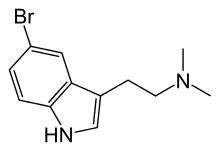5-Bromo-DMT
5-Bromo-DMT (5-bromo-N,N-dimethyltryptamine) is a psychedelic brominated indole alkaloid found in the sponges Smenospongia aurea and Smenospongia echina, as well as in Verongula rigida (0.00142% dry weight) alongside 5,6-Dibromo-DMT (0.35% dry weight) and seven other alkaloids.[1][2][3][4] It is the 5-bromo derivative of DMT, a psychedelic found in many plants and animals.
 | |
| Legal status | |
|---|---|
| Legal status |
|
| Identifiers | |
| |
| CAS Number | |
| PubChem CID | |
| ChemSpider | |
| UNII | |
| CompTox Dashboard (EPA) | |
| Chemical and physical data | |
| Formula | C12H15BrN2 |
| Molar mass | 267.170 g·mol−1 |
| 3D model (JSmol) | |
| |
| |
5-Bromo-DMT has a pEC50 value of 5.51 for the 5-HT2A receptor.[5]
Animal studies on 5-Bromo-DMT showed that it produces effects suggestive of sedative and antidepressant activity and caused significant reduction of locomotor activity in the rodent FST model.[6]
5-Bromo-DMT was reported to be psychoactive at 20–50 mg via vaporization with mild psychedelic-like activity.[7]
Legality
5-Bromo-DMT is specifically listed as a controlled drug in Singapore.[8] It is also banned under analogue provisions in a number of other jurisdictions.
Related compounds
References
- Mark T. Hamann; Anna J. Kochanowska; Abir El-Alfy; Rae R. Matsumoto; Angelo Boujos (2 February 2012). "Patent US 20120029010 - Method to use compositions having antidepressant anxiolytic and other neurological activity and compositions of matter". Retrieved 21 October 2015.
- Arlette Longeon; Brent R. Copp; Elodie Quévrain; Mélanie Roué; Betty Kientz; Thierry Cresteil; Sylvain Petek; Cécile Debitus; Marie-Lise Bourguet-Kondracki (May 2011). "Bioactive Indole Derivatives from the South Pacific Marine Sponges Rhopaloeides odorabile and Hyrtios sp". Marine Drugs. 9 (5): 879–888. doi:10.3390/md9050879. PMC 3111189. PMID 21673896.
- Jin-Feng Hu; John A. Schetz; Michelle Kelly; Jiang-Nan Peng; Kenny K. H. Ang; Horst Flotow; Chung Yan Leong; Siew Bee Ng; Antony D. Buss; Scott P. Wilkins; Mark T. Hamann (March 2002). "New Antiinfective and Human 5-HT2 Receptor Binding Natural and Semisynthetic Compounds from the Jamaican Sponge Smenospongia aurea". Journal of Natural Products. 65 (4): 476–480. doi:10.1021/np010471e. PMID 11975483.
- Peter Djura; Donald B. Stierle; Brian Sullivan; D. John Faulkner; Edward V. Arnold; Jon Clardy (April 1980). "Some metabolites of the marine sponges Smenospongia aurea and Smenospongia (.ident.Polyfibrospongia) echina". Journal of Organic Chemistry. 45 (8): 1435–1441. doi:10.1021/jo01296a019.
- Thorsten Matzdorf (10 March 2015). "5-Carboxamidotryptamin-Derivate als Liganden für 5-HT7- und 5-HT2A-Rezeptoren: Synthese und In-vitro-Pharmakologie" (in German). Universität Regensburg. Retrieved 21 October 2015.
- Anna J. Kochanowska; Karumanchi V. Rao; Suzanne Childress; Abir El-Alfy; Rae R. Matsumoto; Michelle Kelly; Gina S. Stewart; Kenneth J. Sufka; Mark T. Hamann (January 2008). "Secondary Metabolites from Three Florida Sponges with Antidepressant Activity". Journal of Natural Products. 71 (2): 186–189. doi:10.1021/np070371u. PMC 4918908. PMID 18217716.
- Hamilton Morris; Jason Wallach (26 March 2013). "Sea DMT: God Molecule or Barnacle Repellent?". Vice. Retrieved 21 October 2015.
- "Misuse of Drugs Act - Singapore Statutes Online". sso.agc.gov.sg.